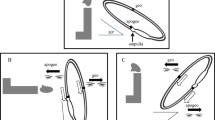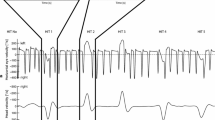Abstract
Upward and downward bias of eye movement signals in the semicircular canals (SCC)- and/or otolith-related central pathways have been proposed to explain the occurrence of vertical nystagmus (downbeat nystagmus [DBN] and upbeat nystagmus [UBN]) and its frequent modulation with head position. Video-head impulse test (VHIT), usually performed in upright position, is a recent development for measuring SCC function. We performed longitudinal nystagmus and VHIT assessments in different head positions in a patient with probable thiamine deficiency, in order to explore a possible relationship between the positional behavior of vertical nystagmus and SCC function. Initially, UBN in upright position changed to DBN in prone position and remained relatively unchanged in supine position. This was associated with both anterior and posterior SCC hyperactive responses in upright position, and a relative enhancement of the anterior SCC responses in prone position and the posterior SCC responses in supine position. Over 1 year, in prone position, change from UBN to DBN and the enhancement of anterior SCC responses remained, while in supine position, UBN either decreased or changed to DBN, when compared to upright position. This was associated with a relative enhancement of the anterior SCC responses in supine position, albeit inconsistently, and the presence of posterior SCC hypoactive responses in all positions, including prone. While not contradicting a primary otolithic dysfunction in the genesis of UBN change to DBN with head position, we provide evidence for positional modulation of SCC function in thiamine deficiency and a possible relationship with nystagmus positional behavior.

Similar content being viewed by others
References
Kattah JC, Dhanani SS, Pula JH, Mantokoudis G, Tehrani ASS, Toker DEN. Vestibular signs of thiamine deficiency during the early phase of suspected Wernicke encephalopathy. Neurol Clin Pract. 2013;3:460–8.
Kattah JC, McClelland C, Zee DS. Vertical nystagmus in Wernicke’s encephalopathy: pathogenesis and role of central processing of information from the otoliths. J Neurol. Springer Berlin Heidelberg; 2019;1–7.
Chambers BR, Ell JJ, Gresty MA. Case of downbeat nystagmus influenced by otolith stimulation. Ann Neurol. 1983;13:204–7.
Gresty M, Barratt H, Rudge P, Page N. Analysis of downbeat nystagmus. Otolithic vs semicircular canal influences. Arch Neurol. 1986;43:52–5.
Lee S-H, Kim S-H, Kim J-M, Tarnutzer AA. Vestibular dysfunction in Wernicke’s encephalopathy: predominant impairment of the horizontal semicircular canals. Front Neurol. 2018;9:141.
Kattah JC, Tehrani AS, du Lac S, Newman-Toker DE, Zee DS. Conversion of upbeat to downbeat nystagmus in Wernicke encephalopathy. Neurology. 2018;91:790–6.
Pierrot-Deseilligny C, Milea D. Vertical nystagmus: clinical facts and hypotheses. Brain. Oxford University Press; 2005;128:1237–46.
Leigh RJ, Zee DS. The neurology of eye movements. 5th ed. New York: Oxford University Press; 2015.
Kim JI, Somers JT, Stahl JS, Bhidayasiri R, Leigh RJ. Vertical nystagmus in normal subjects: effects of head position, nicotine and scopolamine. J Vestib Res. 2000;10:291–300.
Marti S, Palla A, Straumann D. Gravity dependence of ocular drift in patients with cerebellar downbeat nystagmus. Ann Neurol. 2002;52:712–21.
Lemos J, Martins AI, Duque C, Pimentel S, Nunes C, Gonçalves AF. Positional testing in acute vestibular syndrome: a transversal and longitudinal study. Otol Neurotol. 2018.
Author information
Authors and Affiliations
Contributions
André Jorge contributed to acquisition, analysis, and interpretation of the data and drafting of the manuscript. Ana Inês Martins contributed to acquisition, analysis, and interpretation of the data and drafting of the manuscript. Ana Gouveia contributed to acquisition, analysis, and interpretation of the data. João Lemos contributed to acquisition, analysis, and interpretation of the data, drafting of the manuscript, study supervision, concept and design, and critical revision of manuscript for intellectual content
Corresponding author
Ethics declarations
Conflict of Interest
The authors declare that they have no conflict of interest.
Additional information
Publisher’s Note
Springer Nature remains neutral with regard to jurisdictional claims in published maps and institutional affiliations.
Rights and permissions
About this article
Cite this article
Jorge, A., Martins, A.I., Gouveia, A. et al. The Use of Video-Head Impulse Test in Different Head Positions in Vertical Nystagmus and Ataxia Associated with Probable Thiamine Deficiency. Cerebellum 19, 611–615 (2020). https://doi.org/10.1007/s12311-020-01140-8
Published:
Issue Date:
DOI: https://doi.org/10.1007/s12311-020-01140-8




